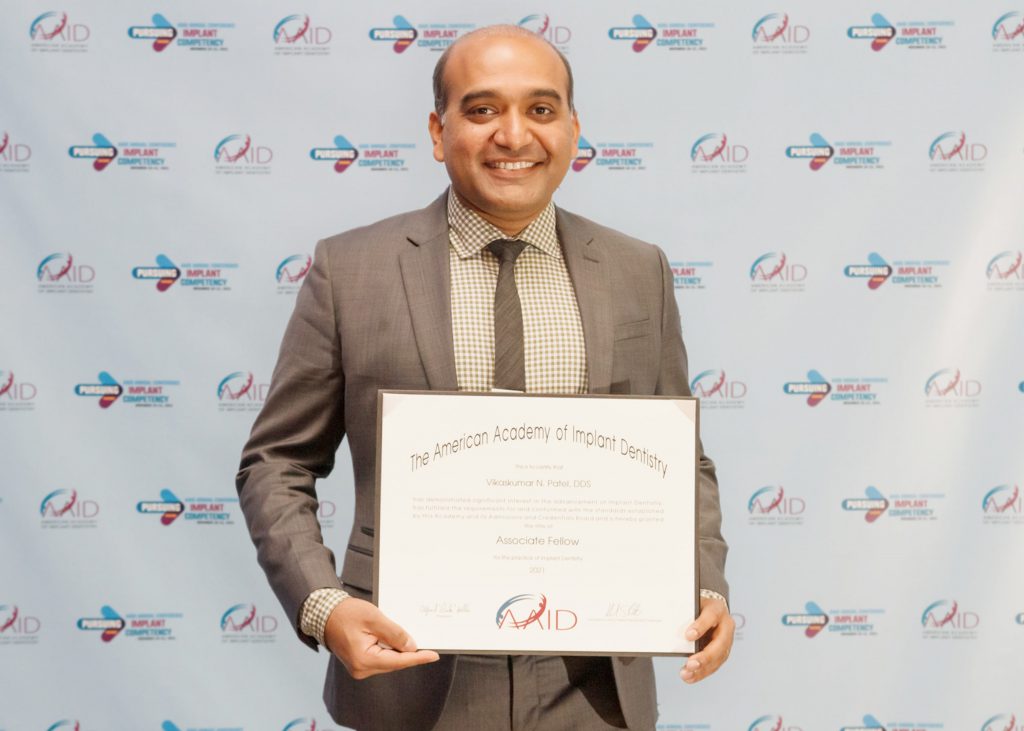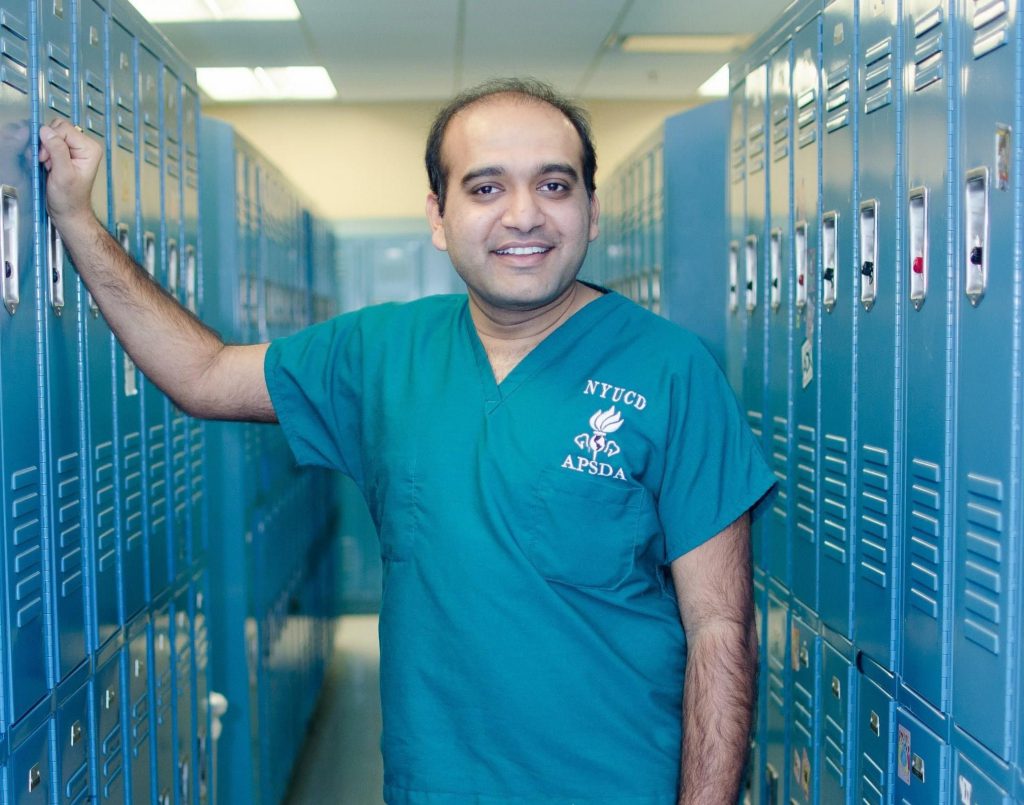Dr. Vikaskumar Patel, DDS, who graduated with a Degree of BDS (Bachelor of Dental Surgery) from Rajiv Gandhi University, in India in 2007 and then graduated with an MBA in Healthcare Administration from Monroe College in New York in 2010 and then received his DDS degree in 2014 from New York University, has been awarded the Fellow of International Congress Of Implantologists (ICOI) and is moving into new developments with Dental Implantology at Smile Savers Dentistry in Columbia, Maryland.
We spoke to him in an exclusive interview about his career and new trends he is seeing.
Why does the field of Dental Implantology excite and interest you the most?
I love dental implantology. It has changed the dental field quite a lot. Restoring a missing tooth, or teeth, can have such a big impact on the lives of patients. With missing teeth, or no teeth at all, chewing becomes very difficult or impossible. The diet then becomes restricted to soft, easily chewed foods. This kind of diet might not meet the nutritional needs of the body, which can cause constipation, weight loss, arthritis, indigestion, and rheumatism.
Missing teeth can also impact one’s socio-economic status. Painful, unesthetic dentition and ill-fitting dentures can cause low self-esteem and cause problems with speaking and eating. They can affect the relationships you have with family, friends, coworkers, or complete strangers. You may not notice that if you’re missing a molar, but a front tooth? That’s going to have a huge impact on your self-confidence. The minute I finish restoring a front tooth, there is an immediate change in the patient’s demeanor.
Implants are also an ever-evolving technology and I love gadgets. You could say I collect them.
Learning all of the advanced technology which helps you place better implants is very exciting.
How did it feel to be awarded the Fellowship from the International Congress of Oral Implantologists (ICOI) and the American Academy of Implant Dentistry (AAID)?
Of course, it always feels good to be rewarded for hard work. I am extremely humbled and honored to be recognized by such a distinguished group of my peers from across the nation.
The fellowship is extremely competitive. To qualify, I had to complete a minimum of 300 hours of post-doctoral instruction in implant dentistry, perform implant surgeries, and then pass the academy’s written and oral examination. The examination was extremely difficult; it is conducted by an expert panel of implant dentists and included a written examination, a series of oral examinations, and defense of my implant cases.
It’s not a simple process, because it measures everything: your clinical proficiency in surgical and prosthetic dental implant techniques, in-depth knowledge of dental implants, and commitment to excellence in implant dental practice and the committee’s standards for ethics and patient welfare.
Plus, I did this on top of running a practice and trying to balance everything with my family life. I am proud to have accomplished all of it.
What new techniques and technology are now available and being used for implantology?
There are many which come to my mind, but the main ones are CBCT, 3D intraoral scanning, and digital printers, which have greatly changed the field of implant dentistry. Using them, I can gather all the details in one appointment and then get the necessary lab work done. I can print a surgical guide for a precise implant placement. The guesswork is eliminated during the surgery and the procedure is completed with minimum trauma.
The 3D printers and milling units are great technology when we need a temporary implant crown, which is especially important in a patient with a missing front tooth. No one wants to walk around missing a front tooth and feeling awkward. We can send our patient home with a milled denture or crown in one single appointment. You don’t have to send cases to the lab and then bring the patient back after some days, which costs more money and causes inconvenience to them. It’s all done in one extremely efficient appointment.
CBCTs aren’t necessarily new technology, but they are becoming a standard of care when placing implants for general dentists and specialists alike. Taking a 3D scan is key to treatment planning in each case. Plus, you can cut down on the number of appointments and surgery time when you merge all these new technologies together.
What advice would you give to other dentists who place dental implants?
I would strongly advise them to embrace new technology, keep up on the latest and greatest advances, and go to as much continuing education as they can.
I also think dentists should get credentialed with the AAID and ICOI. When you are surrounded by colleagues with similar mindsets, you learn from the best of the best and they help you keep up with the breakthroughs in implantology. It’s motivating. Plus, you’re required to keep taking new CE courses, so you always have the most updated information. New technology and CE also enable you to provide the best care possible to your patients. They trust you better, and mostly, I feel that our patients deserve the best version of ourselves.
What about patients? Why should someone get an implant?
A dental implant is simply the best alternative to your natural teeth. There are other ways to do that, like bridges and partials/dentures, but an implant is the best long-term solution.
There are three big reasons that patients don’t get implants. One is cost, another is fear of surgery, and the third important reason is time. Traditional implants take multiple surgeries and appointments. Utilizing the latest technology, you can address all three of these concerns.
An implant is also better for the other natural teeth. For instance, if you’re placing a bridge, you’ve got to remove tooth structure from the adjacent teeth. If those teeth are otherwise healthy, you’re jeopardizing their integrity. The same goes for a partial denture. The clasps that are used to anchor the partial put undue pressure on other teeth.
A partial denture is just a slow road to a complete denture.
How has the way you perform procedures now in 2022 with the pandemic been different than in the past years?
Fortunately, the practices that we use during the pandemic haven’t needed to change much. In terms of my implant surgeries, I was already focusing heavily on immediate implant placement, which significantly reduces the cost and number of appointments.
Traditionally, after tooth extraction, dentists would allow 6-8 month for healing time before they placed an implant. In that healing time, bone resorbs and disintegrates. That makes implant placement very challenging, as you end up with less bone to work with. Many cases require extensive bone grafting procedures and another few months of waiting time.
These multiple appointments at the dental office add more cost for the patients. Each appointment has a cost in terms of both chair time and cost of resources. The more appointments each patient has, the more PPE is used and the more chances of exposure you have for your patient and your staff.
An immediate implant doesn’t require multiple appointments and all that waiting time in between each appointment. With proper use of advanced technology and case planning, I can extract teeth and place implants at the same appointment. In many cases, I am even able to do provisional restoration for the patient on that same day, before they walk out of my office. This saves almost 8-9 months of time. I can cut down on multiple surgical appointments, which is a big help for the patient.
Many patients who need implants are elderly and at that stage where they have other health concerns, such as diabetes, high blood pressure, cancer, etc. Multiple surgeries put them at risk of other critical health complications, especially now with COVID, when you want to minimize aerosol exposure. Immediate implantation also saves PPE use and cuts down on the number of appointments in the clinic. This makes for happy patients and happy staff.
The cost savings we see with placing immediate implants can be significant. I believe that every person should have access to dental care, and with this approach I can make implants more affordable for my patients.
Why do you simply love being a dentist?
I am a people person. I love to help people and dentistry is the perfect way to help and serve. The smile that comes my way after restoring missing teeth and getting a patient out of pain or discomfort keeps me going. I practice general dentistry as well, so I get to meet and treat a variety of patients. It’s fun to establish those relationships and then satisfying to watch your patient’s progression into health.
Like I said earlier, I also really love technology and gadgets. It’s not just the field of implantology that is constantly evolving – there are new developments in other aspects of dentistry as well. I keep up with each new development and make sure we always have the best equipment and supplies to treat our patients.
What are your plans and goals for the future?
This year, I’m planning to create a complete digital center in our office. We’re going to take all our technology and merge it together—our CBCT, our 3D printer, and milling units. We’re going to continue using the technology we have and invest in more as it comes out.
I also want to help, educate and guide other dentists. I’ll be holding continuing education courses myself, and I’ll be presenting at study clubs. I want to help other dentists provide the same high level of care to their patients as I do to my own.















